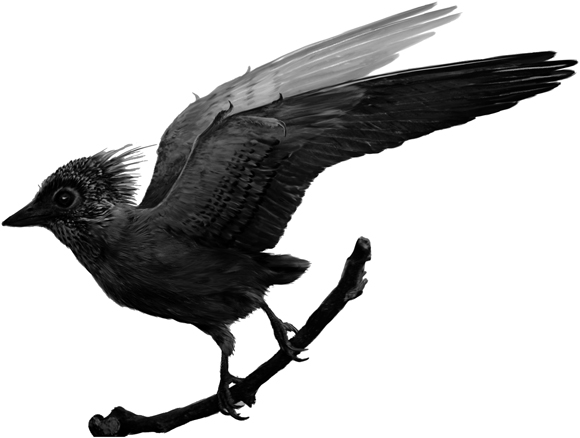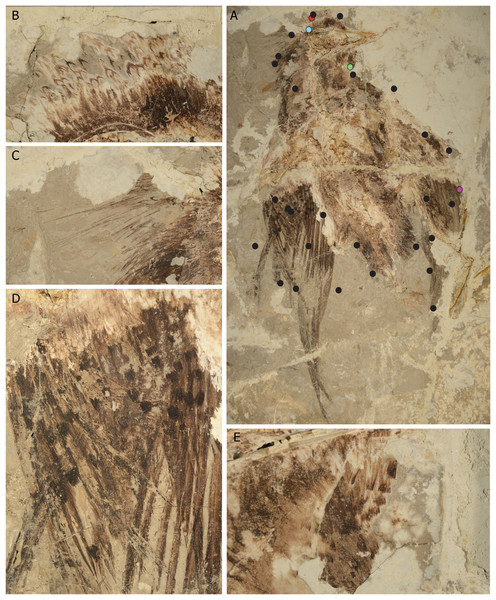Elaborate Plumage in Confuciusornis Described in New Paper
Patterns on the Feathers of Confuciusornis as Complex as Modern Birds
A team of international scientists, including researchers from the China University of Geosciences (Beijing), the University of Ghent (Belgium) and the University of Texas at Austin (United States), have discovered that the patterns on the feathers of an Early Cretaceous bird may have been very similar to and as complex as the patterns seen on the feathers of extant Aves. Writing in the academic, on-line journal “PeerJ”, the researchers conclude that the patterning of Confuciusornis feathers probably performed similar functions to the patterning on modern bird’s feathery coats, that is, they provided camouflage and also played a role in display.
Confuciusornis Integumentary Covering – Elaborate Plumage

Picture credit: Li et al (PeerJ)
Complex Patterning Detected by Sophisticated Chemical Analysis
The specimen studied consists of a slab and counter slab of a single, individual bird from Early Cretaceous deposits in Fengning County, Hebei Province (north-central China). The fossils are from the vertebrate collection of the China University of Geosciences and represent an example of Confuciusornis sanctus.
The research team identified exceptional feather preservation but poor preservation of the bones, the unusual state of preservation permitted the scientists to identify melanin signals in the fossilised feathers indicating a complex patterning of spots on the wings, throat and on the tuft of feathers at the back of the head forming a small crest. The shape of the structures that form these patterns in conjunction with chemical analysis confirmed the diagnosis of the pigment melanin. However, specific colouration associated with the patterns could not be discerned.
The Slab and Counter Slab or a C. sanctus Specimen Reveals Complex Patterning on the Plumage

Picture credit: Li et al (PeerJ)
The photograph (above) shows various views of the main slab of the fossil specimen showing details of the plumage. The dots in (A) indicate places that were subjected to sampling, whereas B and C reveal the crest located on the back of the head. Parts D and E show elements of the integumentary covering in close detail.
A Range of Analytical Techniques Used to Study Confuciusornis
Using a range of analytical techniques including scanning electron microscopy and ion mass spectrometry (ToF-SIMS) the researchers concluded that the elaborate spotting on this specimen exceeds that found in exceptionally-preserved troodontids and compsognathids and rivals that in modern birds, suggesting that plumage patterns evolved greater complexity through avian evolution.
The exact age of the strata is uncertain, although it is believed that the deposits from Fengning County are approximately equivalent in age with the Dawangzhangzi Member of the Yixian Formation, around 122-123 million years old (Aptian faunal stage of the Early Cretaceous). The data from this study suggests that Confuciusornis had more complex patterning than the patterning identified in Achiornis or in the stripes of the compsognathid Sinosauropteryx. The research team conclude that this specimen of a primitive bird provides evidence to support the idea that complex patterning of feathers evolved at a relatively early stage in avian evolution.
The Chinese manufacturer PNSO have produced a model of Confuciusornis.
To view the PNSO model range: PNSO Age of Dinosaurs Replicas and Models.
The Link to Barn Owls
Integumentary patterns and colours play a variety of roles in living birds. Such patterning in fossil specimens probably performed the same sort of functions and in addition, they can help to inform on the habitat in which the extinct creature lived. In some modern bird groups, barn owls for example (Strigiformes), it has been observed that the size and placement of the spots on the feathers play a role in mate selection. Male barn owls tend to prefer females with larger spots. The patterning identified on this C. sanctus specimen leads to the intriguing idea that for confuciusornithids, just like barn owls, the location and the size of the spots on the plumage played a role in choosing a mate.
The scientific paper: “Elaborate Plumage Patterning in a Cretaceous Bird” by Quango Li, Julia A. Clarke, Ke-Qin Gao, Jennifer A. Peteya and Matthew D. Shawkey published in PeerJ.
Visit the Everything Dinosaur website: Everything Dinosaur.

